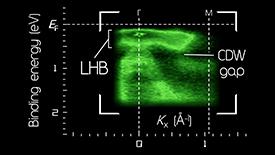

12/27/2021

© 2021 Takafumi Sato
An AIMR-led team has isolated a room-temperature (RT), two-dimensional (2D) Mott-insulator phase of a single-layer 1T-TaSe21. Using angle-resolved photoemission spectroscopy (ARPES), the team has determined that the enhancement of the Mott-transition temperature stems from the interplay between exotic quantum features and low dimensionality. These results open a pathway toward the realization of RT Mottronic devices and high-temperature superconductors.
Superconductivity occurs in complex systems such as doped copper oxides (at T < 200 K) and tilted graphene bilayers (at T ~1 K). According to the Hubbard model, these superconductivity examples are associated with the Mott insulator—a phase that emerges when the electron correlation (U) of a material significantly exceeds the width of its partially filled band (W).
The Hubbard model also implies that the Mott transition of a material is triggered when physical conditions (e.g., temperature, pressure, and dopants) maximize the material's effective Coulomb interaction (U/W), suggesting a strategy toward RT Mott-transition: maximizing U/W using low dimensionality.
Here, the team demonstrates this strategy using 2D transition-metal dichalcogenides (TMDs) such as the single-layer 1T-TaSe2.
“Because the bulk 3D 1T-TaSe2 undergoes Mott transition at low T (< 200 K), reducing its dimensions to 2D should raise its U/W value, enhancing the Mott-transition temperature,” says Takafumi Sato, the principal investigator. “The key lies in designing a set of experiments that can demonstrate this possibility.”
To this end, the team combines ARPES with other spectroscopic techniques to monitor U/W-defining electronic features. While the simultaneous observation of the Mott gap and the charge-density-wave (CDW) gap at T = 40 K suggests that the 2D 1T-TaSe2 is a Mott insulator, the observation of the lower Hubbard band up to T = 450 K indicates the Mott-insulator phase is robust at RT and beyond.
“We have discovered a unique, 2D RT Mott insulator phase,” says Sato. “This is only possible thanks to an exquisite interplay where U is enhanced by exotic features such as CDW, and W is reduced by 2D confinement.”
Future work on 2D TMDs will aim at demonstrating the Mott-insulator to metallic phase transitions at RT, and at detecting high-temperature superconductivity.
(Author: Patrick Han)
This research highlight has been approved by the authors of the original article and all information and data contained within has been provided by said authors.